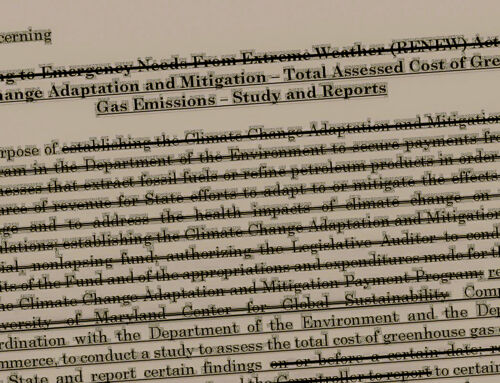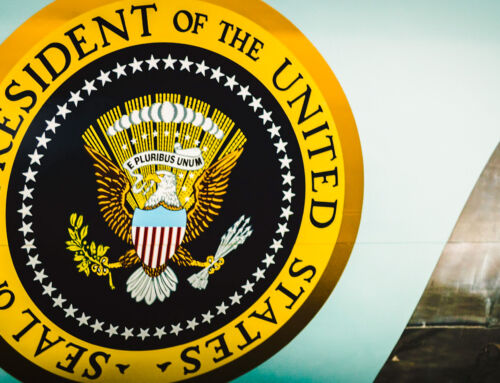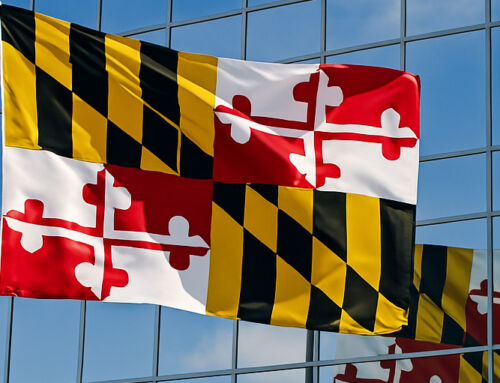View by Topic
Recent Articles
-
New Environmental Laws from the 2025 Maryland Legislative SessionSaturday, April 26th, 2025
-
Migratory Bird Treaty Act Does Not Prohibit Incidental Take – AgainSaturday, April 19th, 2025
-
President Trump’s Bold Step to Rein in State Overreach in Climate ChangeSaturday, April 12th, 2025
-
Mandatory GHG Disclosures in Maryland Real Estate ContractsSaturday, April 5th, 2025
View by Month/Year
“Green Building Law Update” Headlines
Recent Articles & News from
Stuart Kaplow’s blog
at GreenBuildingLawUpdate.com
- BEPS Redux: The Most Far Reaching Environmental Legislation of the 2025 Maryland General Assembly May 4, 2025
- New Environmental Laws from the 2025 Maryland General Assembly Session April 27, 2025
- Migratory Bird Treaty Act Does Not Prohibit Incidental Take – Again April 20, 2025
- President Trump’s Bold Step to Rein in State Overreach in Climate Change April 13, 2025
Subscribe to the Green Building Law Update!
Stuart Kaplow brings his expertise and extensive experience to the table with his unique digital publication, "Green Building Law Update". Subscribers receive regular updates to keep them informed about important issues surrounding Environmental Law, Green Building & Real Estate Law, as well as the emerging demand for Environmental Social Governance (ESG).
Get fresh content through the lense of Stuart Kaplow's cutting-edge expertise, innovative commentary and insider perspective. Don't miss another issue! Subscribe below.
Military will Continue to Pursue LEED Silver
The Department of Defense will continue to pursue LEED® Silver certification for new construction and major renovations.
This is huge news not only because the Air Force, Army, Marines, Navy and other instrumentalities of the Department of Defense own and operate 299,000 buildings and 211,000 additional structures, making it the largest owner of buildings in North America, but it is also the owner or more LEED certified buildings than anyone else. And most significantly, the DOD has become an important agent of disruptive innovation improving the knowledge base on high performance buildings and leading the way in installation of cutting edge energy efficiency and sustainability technologies.
The DOD spends more than $3.4 Billion on energy to power, heat and cool that more than half a million structures. That amount of energy used is more than 1% of all the energy used in the U.S. So it is not surprising that Congress, several Administrations and the DOD itself have involved themselves in matters of resource use.
The National Defense Authorization Act for the fiscal year 2012 (signed on December 31, 2011 by President Obama), section 2830(b)(1) provided, “No funds authorized to be appropriated by this Act or otherwise made available for the Department of Defense for fiscal year 2012 may be obligated or expended for achieving any LEED gold or platinum certification.”
And when the National Defense Authorization Act for the fiscal year 2013 was enacted it continued and expanded the limitation of use of funds for LEED Gold or Platinum not just for fy 2012 funds and fy 2013 funds but all funds whether prior appropriated or not.
Significantly, the 2012 Act also required the Secretary of Defense to submit a report to the Congressional defense committees on the energy efficiency and sustainability standards used by DOD for military construction and major renovations of buildings. That report was not submitted and the 2013 Act extended the prohibition on LEED Gold and Platinum “until the date that is six months after the date of the submittal to the congressional defense committees of the report”.
Congress required DOD’s report must include a cost-benefit analysis, return on investment, and long term payback for the building standards and green building certification systems identified: “(a) American Society of Heating, Refrigerating and Air-Conditioning Engineers (ASHRAE) Standard 189.1-2011 for the Design of High-Performance, Green Buildings Except Low-Rise Residential. (b) ASHRAE Energy Standard 90.1-2010 for Buildings Except Low-Rise Residential. (c) Leadership in Energy and Environmental Design (LEED) Silver, Gold, and Platinum certification for green buildings, as well as the LEED Volume certification. (d) And other American National Standards Institute (ANSI) accredited standards.”
DOD’s report to the Congressional defense committees must also include a copy of DOD policy prescribing a comprehensive strategy for the pursuit of design and building standards across the department that include specific energy efficiency standards and sustainable design attributes for military construction based on the cost benefit analysis, return on investment, and demonstrated payback required for the above described building standards and green building certification systems.
A “prepublication copy, subject to further editorial correction” of a report from the National Research Council of the National Academies was released on February 15, 2013. USGBC issued a press release that day entitled, “Military Facilities Reap Huge Benefits From Using LEED, Says Independent Study”.
It is expected that that report, with a brief transmittal memo (but, not an additional substantive report) will be submitted as the required response to the Congressional defense committees as early as April 1, 2013.
The prepublication copy of the report makes nine findings, the first of which is after conducting an extensive literature search, “Finding 1: The committee did not identify any research studies that conducted a traditional benefit-cost analysis to determine the long-term net present value savings, return on investment, or long-term payback related to the use of ASHRAE Standard 90.1-2010, ASHRAE Standard 189.1-2011, and the LEED or Green Globes green building certification systems.”And the National Research Council report “calls into question” the quantity and quality of the data used by the DOD consultant engaged to respond to Congress, Dr. Sara Slaughter, challenging its efficacy concluding, “it calls into question the consultant’s findings related to NPV [net present value] benefits” of green building.
And importantly, “Finding 8. DOD has the opportunity to continue to take a leadership role in improving the knowledge base about high-performance buildings, improving decision-support tools, and improving building models by collecting data on measured energy, water, and other resource use for its portfolio of buildings and by collaborating with others.”
The report also makes five recommendations, including,“Recommended Approach 1. Continue to require that new buildings or major renovations be designed to achieve a LEED-Silver or equivalent rating in order to meet the multiple objectives embedded in laws and mandates related to high-performance buildings.”USGBC’s press release spinning that recommendation into reaping huge benefits may have been a bit of puffing, when the report’s underlying conclusions include, “the evidence that is available is inconclusive regarding whether LEED-Silver-certified buildings outperformed LEED-Certified buildings, or whether LEED-Gold buildings outperformed LEED-Silver buildings.” The current temporary statutory prohibition on LEED Gold and LEED Platinum is expected to become DOD policy and DOD will no longer be chasing a Gold plaque.
Among those statutes and mandates, the two most key to DOD building may be: The Energy Independence and Security Act of 2007 which defines the attributes of high performance buildings, including reductions of energy, water, material, and fossil fuel use, improved indoor environmental quality for occupants, improved worker productivity, and lower life-cycle costs when compared to baselines for building performance. EISA 2007 requires federal agencies to use a green building certification system for new construction and major renovations of buildings.
After initially receiving a consultant report in 2012, determining that Green Globes® better aligned with new construction and LEED better aligned with renovation of existing buildings, on February 5, 2013, GSA and its civilian Federal agency partners announced they had delayed a long awaited action and are seeking additional public input for 60 days “regarding possible approaches GSA may take in fulfilling its requirement” under EISA 2007 to provide a formal recommendation to the Secretary of Energy that identifies a green building certification system “most likely to encourage a comprehensive and environmentally sound approach to the certification of green federal buildings.”
Executive Order 13423 requires that new federal buildings and major renovations comply with the Guiding Principles for Federal Leadership in High-Performance and Sustainable Buildings. The Guiding Principles were last published in the Federal Leadership in High Performance and Sustainable Buildings Memorandum of Understanding, as approved on December 1, 2008: Employ Integrated Design Principles, Optimize Energy Performance, Protect and Conserve Water, Enhance Indoor Environmental Quality, and Reduce Environmental Impact of Materials. Of import, the Guiding Principles were propose for revision in 2012, but politics in Washington DC intervened and it is now expected that a revision will take place in late 2013.
That is, first and foremost DOD building does and will comply with the Guiding Principles.
It is worthy of note that most commentators believe the current fiscal climate will curtail construction of new DOD building in the foreseeable future. In point of fact, the majority of buildings that will be used by DOD in 2030 already exist. Accordingly, the vast majority of future DOD construction will be upgrades or renovations of existing buildings.
The Unified Facilities Criteria (UFC) system provides planning, design, construction, sustainment, restoration, and modernization criteria for DOD. On March 1, 2013, DOD issued the new UFC 1-200-02 High Performance And Sustainable Building Requirement. The new UFC provides minimum standards to achieve high performance and sustainable facilities that comply with EISA 2007, EO 13423, and the Guiding Principles. This UFC is organized around the Guiding Principles. The UFC incorporates most of ASHRAE 189.1-2009. ASHRAE 189.1 is an industry standard for the design of high performance green buildings.
So, the DOD will use UFC 1-200-02 standards to satisfy the Guiding Principles. And to validate the cost savings strategy, the DOD will continue to pursue LEED Silver certification (but not Gold or Platinum) for new construction and major renovations. Accepting that there is no one homogenized military building type, LEED Silver certification, in and of itself, does not satisfy all of the Guiding Principles and by some measures only address 60% or so of the Principles.
Because DOD is USGBC’s largest customer, USGBC has been in discussions about providing a project by project “crosswalk” reporting when a LEED credit on a DOD project satisfies a Guiding Principle. USGBC has described that this crosswalk could be provided online through USGBC’s Green Building Information Gateway (GBIG), an online data base of LEED buildings. However, given that much of DOD’s green building information is not public, a platform other than GBIG seems more likely.
Also out of concern for market share, USGBC has recently floated the idea of providing a “certificate” to DOD LEED projects attesting to when they also satisfy the Guiding Principles.
Which is a long way of saying the Department of Defense will continue to pursue LEED Silver certification for new construction and major renovations. That is huge not only for those that erect buildings on base or lease to instrumentalities of the military, but for the entire real estate industry as the DOD will continue to improve the knowledge base about high-performance buildings.
If we can assist you in complying with military mandates or otherwise in identifying opportunities to lead and profit in green building and sustainable business, do not hesitate to email Stuart Kaplow at skaplow@stuartkaplow.com or give him a call at 410-339-3910.









